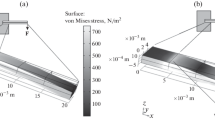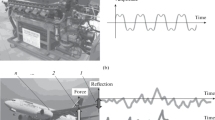Abstract—
The lower eigenfrequency of a piezoelectric accelerometer in fixed and unfixed states was determined by carrying out mounted resonance testing (MRT) of a NEXUS 2692 amplifier. The MRT was complemented by spectral analysis of the piezoelectric-accelerometer response to an electric pulse, which was performed using the fast Fourier transform method. Based on the lower eigenfrequency of the fixed piezoelectric accelerometer determined thereby, it was possible to confirm the quality of sensor fixing on the test object and evaluate the reliability of results obtained after loading.
Similar content being viewed by others
Avoid common mistakes on your manuscript.
When planning measurements of accelerations, one must correctly select the piezoelectric accelerometer, given that the lower eigenfrequency ff of the fixed piezoelectric accelerometer must be much higher than the frequency of the measurable signal f. This problem was generally solved in [1]. In practice, simpler ratios are used to avoid distortion of the measurable-signal frequency, e.g., \({{f}_{{\text{f}}}} \geqslant 12f\).
For various reasons, it is sometimes impossible to place a piezoelectric accelerometer directly on a test object; therefore, gaskets, brackets, adhesives of different rigidities, and other devices can be used to fix the piezoelectric accelerometer. Depending on the method for fixing the piezoelectric accelerometer, its lower eigenfrequency ff may vary significantly (most often, it decreases); therefore, the measured signal may be unreliable or be measured with a large error [2–4]. Even an increase in the layer of adhesive bonding for the same “sensor–test object” pair leads to a decrease in the lower eigenfrequency of the piezoelectric accelerometer. As an example, the lower eigenfrequency of the AP7(AP11) piezoelectric accelerometer fixed using the VGO-1 sealant is 15 kHz or higher at an adhesive-layer thickness of 0.15–0.2 mm and no greater than 8 kHz at 0.7 mm [4].
If the same method is used to fix several piezoelectric accelerometers on the test object it is technologically difficult to provide equal thickness of the adhesive layer and, hence, the necessary lower eigenfrequency of the piezoelectric accelerometer, which will sometimes differ substantially. In practice, it is impossible to quickly check the thickness of the adhesive layer and the quality of the adhesive joint between the sensor and the test object, especially if the sensor is fixed in place inside the test object. Therefore, in our opinion, the determination of the lower eigenfrequency of the piezoelectric accelerometer after its mounting on the test object is an urgent task.
An electrical method for determining the lower eigenfrequency of the piezoelectric accelerometer in the fixed state was proposed by Bruel & Kjer (www.bksv.ru). Mounted resonance testing (MRT) is carried out using a NEXUS 2692-C-001 amplifier (hereinafter referred to as NEXUS) from this company. The key characteristics of this amplifier are listed below:
—nominal charge conversion limit, 105 pC;
—output voltage, ≤10 V;
—nominal conversion factors, from 10–5 to 10 V/pC;
—upper cutoff frequencies: 0.1, 1, 3, 10, 22.4, 30, and 100 kHz.
The MRT is performed as follows. A bipolar rectangular voltage pulse with an amplitude of 15 V, a duty cycle of 2 units, and a preset duration (from 0.01 to 0.1 μs) is generated at the input of the amplifier to which a piezoelectric accelerometer is connected. This pulse initiates vibration of the sensitive element of the piezoelectric accelerometer. The NEXUS amplifier is then switched to the measurement mode and automatically measures the time T that is spent on measuring N periods of the sensor response signal (N is specified by the testing algorithm). The measured frequency F = N/T is calculated after the measurements and is shown on the display of the amplifier. It should be noted that, apart from the vibration eigenfrequency of the fixed piezoelectric accelerometer, the piezoelectric-accelerometer response also contains vibration frequencies of the inertial mass that is a part of the piezoelectric accelerometer (the vibration eigenfrequency of the unfixed piezoelectric accelerometer).
In practice, an attempt to apply the MRT to domestic AP77M piezoelectric accelerometers manufactured by GlobalTest Co. (Sarov, www.globaltest.tu) and AP11 and AP8 piezoelectric accelerometers manufactured by the Ural Electromechanical Plant (Yekaterinburg, www.uemz.ru), which were fixed on the test object, failed to provide a positive result. The test results were random and did not correspond to the values of the lower eigenfrequency of the piezoelectric accelerometer presented in [2, 4]. A possible cause for this was the difference in the design of the AP11, AP77M, and AP8 sensors from the sensors by Bruel & Kjer (a 4344-type sensor was used for the comparison). The AP11, AP8, and Bruel & Kjer 4344 sensors (Figs. 1a and 1b) use the compression scheme. Nevertheless, in the AP11 and AP8 sensors, the piezoelectric element is pressed by a top sensor over and, in the Bruel & Kjer 4344 sensor, by a screw that is screwed into the sensor base [2]. The AP77M sensor is built according to a shear scheme (Fig. 1c).
The designs of the (a) Bruel & Kjer 4344, (b) AP8 and AP11, and (c) AP77 piezoelectric accelerometers: (1) case cover, (2) disk spring, (3) screw, (4) inertia member, (5) piezoelectric ceramics, (6) current output, (7) case, (8) threaded hole for a removable stud, (9) ball, (10) fixed stud (shank), (11) insulating sleeve, (12) conical support, (13) cable port, (14) cable, (15) cable entry unit, (16) wire binding, (17) external insulation, (18) shield, (19) internal insulation, (20) lead, (21) solder that fastens the binding, and (22) solder that fixes the cable entry unit inside the case.
We proposed to complement the MRT with a spectral analysis of the piezoelectric-accelerometer response, which was measured according to the diagram shown in Fig. 2. During the MRT, the response of the piezoelectric accelerometer was recorded by the first channel of the AKIP 4122/4 oscilloscope, and the driving voltage pulse generated by the NEXUS S/N 2 645 254 amplifier was recorded by the second channel. After the recording, the fast Fourier transform (FFT) of the piezoelectric-accelerometer response was calculated and the lower eigenfrequency of the piezoelectric accelerometer was determined by the extremum in the FFT spectrum.
In the course of the investigations, 30 experiments were conducted with AP11, AP77M, and AP8 piezoelectric accelerometers fixed in various ways (Fig. 3). When the eigenfrequencies of the unfixed piezoelectric accelerometer were determined, the latter was suspended by its own cable.
The lower eigenfrequencies of the piezoelectric accelerometer in the fixed and unfixed states are presented in Tables 1 and 2. Typical examples of recorded signals are shown in Fig. 4. The extremum of the spectrum at the lower eigenfrequency of the piezoelectric accelerometer in the fixed and unfixed states is clearly distinguishable in the FFT spectra that are also shown in Fig. 4. The amplitude of this peak increases as the frequency of the driving electric pulse generated by the NEXUS amplifier approaches the eigenfrequency of the sensitive element in the piezoelectric accelerometer.
Typical examples of the recorded signals for the piezoelectric accelerometer (a) in the fixed and (b) unfixed states. At the top are the signals at the recorder input: the driving pulse is shown with the dashed line and the piezoelectric-accelerometer response is shown with the solid line; at the bottom is the FFT spectrum of the piezoelectric-accelerometer response.
Based on the results of the investigations, the following conclusions can be drawn.
1. The use of the NEXUS amplifier MRT for determining the lower eigenfrequency of the domestic AP11, AP77M, and AP8 piezoelectric accelerometers that were fixed in place on the test object using adhesive bonding showed that the results are random in character.
2. By complementing the MRT of the NEXUS amplifier with the spectral analysis of the piezoelectric-accelerometer response to the driving voltage pulse, it is possible to obtain correct values of the lower eigenfrequencies of the piezoelectric accelerometer in the fixed and unfixed states, which are consistent with the data in [4] and with the sensor ratings (specifications data).
3. The use of the NEXUS amplifier MRT in combination with the spectral analysis of the piezoelectric-accelerometer response makes it possible to quickly determine the lower eigenfrequency of the piezoelectric accelerometer that was fixed in place on the object before the tests. This test of the quality of the piezoelectric-accelerometer fixing on the test object reduces the risk of obtaining unreliable experimental results.
4. The method for spectral analysis of the piezoelectric-accelerometer response to a driving pulse is not bound to the proposed measuring system and can be applied to other measuring systems and piezoelectric accelerometers or used as a basis for creating a device for assessing the quality of the piezoelectric-accelerometer fixing.
REFERENCES
Krylov, A.N., Izbrannye trudy (Selected Scientific Works), USSR Acad. Sci., 1958, pp. 315–360.
Sobolev, M.D., Loginov, P.M., and Ivashin, N.A., Zashchita datchikov udarnykh uskorenii ot neizmeryaemykh mekhanicheskikh vozdeistvii (Protection of Impact Sensors Against Unmeasurable Mechanical Effects), Snezhinsk: Russian Federal Nuclear Center, All-Russian Research Institute of Experimental Physics, 2018.
Aviatsionnye pribory. Lektsii po AV i IVK/Lektsii/08 (Aviation Instruments. Lectures on AV and IVK/Lectures/08), Ufa State Aviation Technical University.
Kolesnikova, L.A., Mal’gun, M.M., Skrypnikova, L.F., and Sobolev, M.D., Izmer. Tekh., 1990, no. 2, p. 35.
Author information
Authors and Affiliations
Corresponding author
Additional information
Translated by N. Goryacheva
Rights and permissions
About this article
Cite this article
Borozenets, A.S., Garaev, D.Y., Proskurin, A.V. et al. Determination of the Lower Eigenfrequency of Vibrations of a Piezoelectric Accelerometer. Instrum Exp Tech 62, 718–722 (2019). https://doi.org/10.1134/S0020441219050063
Received:
Revised:
Accepted:
Published:
Issue Date:
DOI: https://doi.org/10.1134/S0020441219050063








